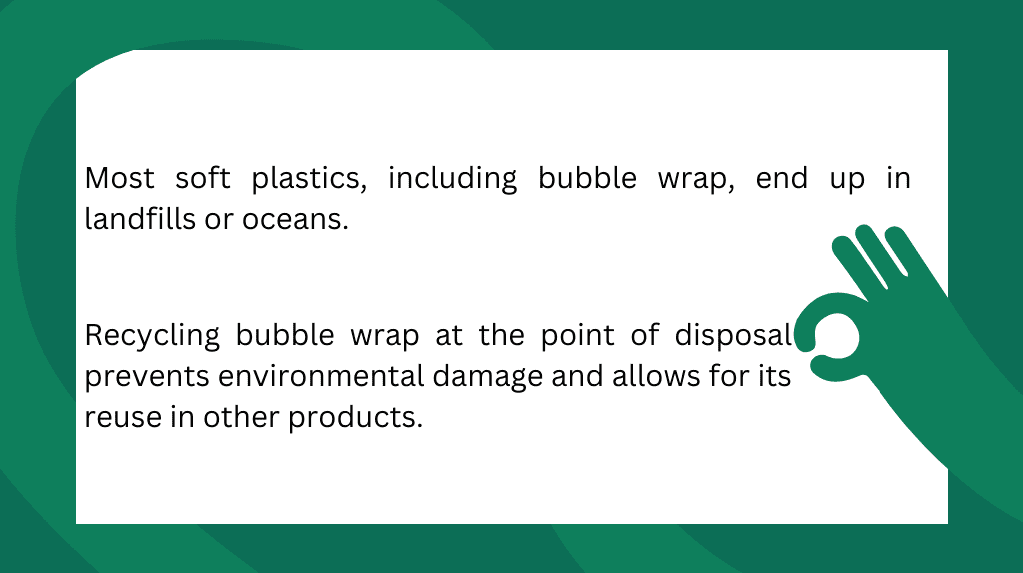
Plastic pollution is undeniably a global problem - every year between 19 and 23 million tonnes of plastic waste leaks into our seas, rivers, and lakes. We use many plastic products in our everyday lives, which ultimately contributes to mass pollution in our ecosystems.
The key to reducing mass pollution is individual education on what you can and can’t recycle. Sure, putting one box or plastic sleeve in the wrong bin may not seem like a major issue, but it’s these collective decisions that play a big role in how society successfully recycles and manages waste to prevent pollution.
Many of us will have received fragile parcels that have been cushioned by bubble wrap to ensure safe transit to you. Bubble wrap is a plastic product that is great for getting things safely from A to B, thanks to the air-filled holes that keep things protected. However, have you ever wondered what you do with this plastic material once its role is fulfilled?
In this article, we’ll answer that question for you. Read more to find out exactly what bubble wrap is made from, how you’re supposed to recycle it, and where you can dispose of it correctly in the future.
Table of contents
- Is Bubble Wrap Recyclable?
- The Importance of Recycling Bubble Wrap
- How To Recycle Bubble Wrap in Australia
Is Bubble Wrap Recyclable?

The short answer to the question of ‘Is bubble wrap recyclable?’ is yes, it is. However, before you make a dash for your household yellow bin, there are a few things you need to know.
Bubble wrap is made from a low-density type of polyethene film — the same material that most plastic bags are made out of. According to the City of Sydney’s home recycling guide, bubble wrap is classified as a type of ‘soft plastic’ and can’t be recycled normally like other types of hard plastics like containers and bottles that you’d toss into yellow-lid bins.
Soft plastics, which include items such as plastic bags, shrink wrap and plastic wrappers, are the number one contaminator in the recycling system today. These thin sheets are easily caught in the recycling conveyor belt, wreaking havoc on the whole recycling system and potentially causing machines to jam.
Subsequently, this means soft plastics often have to be thrown out with general waste, as recycling bins won’t take them. They will often be separated from acceptable recyclables and sent to landfill, where it can take up to 1,000 years for these items to decompose.
However, there are ways to recycle and reuse bubble wrap. Firstly, you could repurpose this and use it to cushion other items or for art projects. You can also drop soft plastics off at designated areas.
The Importance of Recycling Bubble Wrap

Australia has been facing a plastic recycling problem over the past couple of years — from 2018 to 2019, only 18% of all plastic packaging within the country was recycled or composted. This percentage has since dropped to 16% from 2019 to 2020.
The result is that the majority of soft plastics like bubble wrap end up in a landfill, or worse, in the ocean. Like other types of soft plastic, bubble wrap will take hundreds to thousands of years to decompose naturally at a landfill, contaminating and polluting our planet’s already fragile environment.
Poorly disposed bubble wrap that finds its way into water sources poses a more direct danger to marine life, as it is easily mistaken for jellyfish by fins turtles or dolphins who may end up choking on it while trying to eat it. Worse still, this pollution can work its way up the food chain and end up poisoning humans as well.
Recycling bubble wrap at the source of disposal is the best way to ensure that this doesn’t happen while also providing the opportunity to reuse this waste for other useful products.
How To Recycle Bubble Wrap in Australia

Being a soft plastic, bubble wrap can be recycled in the same way as other types of plastic films with some small differences. Here are some simple steps to follow to recycle bubble wrap in the proper way:
- Remove all paper or sticker labels from the bubble wrap. Separating these materials will help ensure that the recycling process can be done smoothly.
- Ensure that the bubble wrap is free from food or liquid waste.
- Place the unwanted bubble wrap in a separate container instead of tossing them into red-lid bins.
- Engage a rubbish removal service to help take your bubble wrap waste to an appropriate soft plastics recycling centre.
Once it is at a proper soft plastic recycling facility, bubble wrap is usually recycled through the use of specialised machinery designed to break it into smaller, more manageable pieces. Once broken down, the pieces are turned into small pellets through a process known as compounding. The pellets can then be turned into a variety of products, such as bin bags, furniture or flooring.
Final Thoughts
When disposed of incorrectly, bubble wrap has a hugely detrimental impact on the environment. Often ending up in landfills, bubble wrap and other substances take many years to break down and can filter into the soil, causing further environmental harm.
In the past, Sydney residents could drop off bubble wrap and other soft plastics for recycling at major grocery stores like Coles and Woolworths. However, this is no longer an available option due to processing issues, making recycling bubble wrap a lot less accessible than before.
The good news is that there are reliable rubbish removal services in Sydney that can still help Sydney households and businesses with bubble wrap recycling. If you are looking to get rid of bubble wrap or other types of soft plastic waste, our professional team of removalists at Ridly can help dispose of and recycle it responsibly.